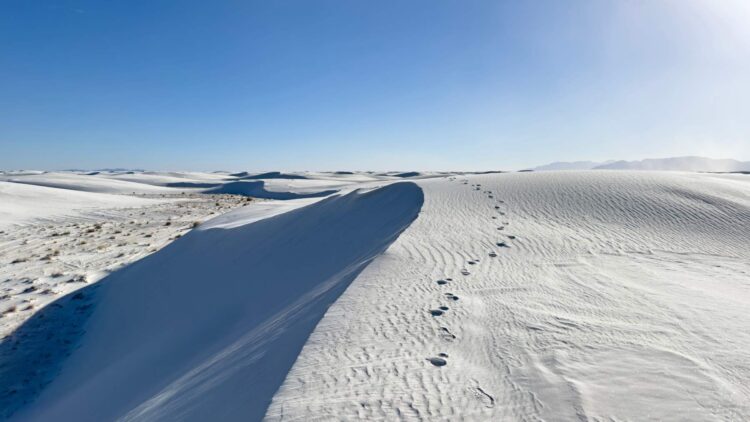Humans have been trying to transport stuff effectively, probably ever since before they were humans. The surprising thing is that all these years later, scientists and researchers continue to find traces of the ways that humans thousands of years ago tried to transport their goods. They have now found new traces of tracks that indicate the use of wheel-less vehicles used around 22,000 years ago.
The newly discovered tracks were found in White Sands National Park, New Mexico, USA, where researchers were studying these newly found tracks. They published their findings in a study, where they described the relevance of their findings “the simplest explanation is that they represent drag marks formed by travois, consisting of a single pole or crossed poles, pulled by humans, presumably for resource transportation. Therefore, this unique footprint record could represent one of the earliest pieces of evidence for the use of transportation technology.”
This is a fascinating discovery considering the fact that the discovery of the wheel is one of the most important milestones for humanity, but this shows that the drive to move and transport things has made us find alternatives and easier ways to carry things. These tracks belong to what is now called a wheelless cart or travois. These carts consist of two wooden poles, held at the front by each hand and crossed at the back in a V or X shape.
The travois were simple vehicle used by Plains Indians, and were usually dragged along the ground to carry meat, game, or other supplies. These are not the first tracks that scientists have found about these types of “vehicles”, as they have been used in multiple civilizations and have been around for centuries after the invention of the wheel, which has been credited to Mesopotamia about 17,000 years after these tracks were made.
Matthew Bennett, the study’s lead author from Bournemouth University explained excitedly why these tracks are so important for history “There is nothing this old”
Where were these vehicle tracks found and what makes them so significant
Besides the age of the tracks, there are a few other things that make them stand out from others that have been found previously. The first thing is that they were found buried in the dried mud of an ancient lake in White Sands National Park, New Mexico. They had been hidden under sediments for centuries and their unearthing has been a combination of natural erosion and archaeological excavation.
The second thing that makes them special, is that usually these tracks are found alongside adult tracks, meaning that adult males would be pulling on the vehicle. This time however, the footprints accompanying them were smaller, and they would have belonged to either women or children. We do not know how far these people travelled or where they were going, but the length of the track that has been unearthed is 30 meters and there could be a lot more information past that point if it is slowly uncovered.
And that would not be surprising, the White Sands National Park (WHSA) is full of archaeological evidence. Researchers of all types have found remains of things like Cenozoic vertebrate footprints, footprints and tracks of Proboscidea (mammoth/mastodon), Folivora (ground sloth), Carnivora (canids and felids), and Cetartiodactyla (bovids and camelids) as well as plenty of human remains.
The more scientists look the more they find, especially since the site has some very unique properties that have made it ideal for studying past lifeforms and behaviors over a very large area of terrain. The region features two primary landforms: a field of gypsum dunes dating back to either the Late Pleistocene or Holocene, and Alkali Flat, a remnant shoreline formed from the eroded basin of the ancient Paleolake Otero, along with deposits from its former lake margins.

